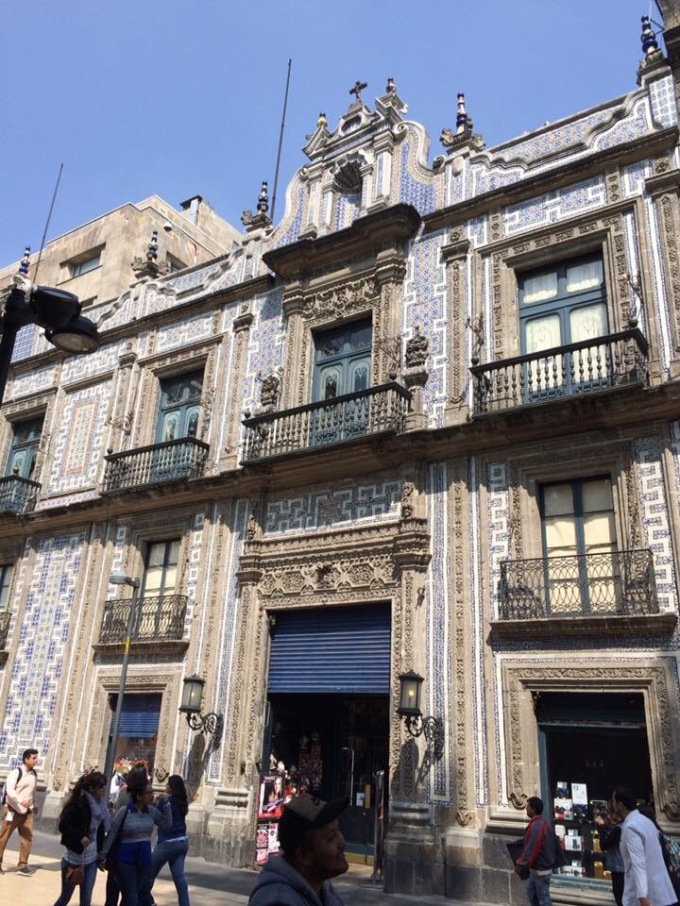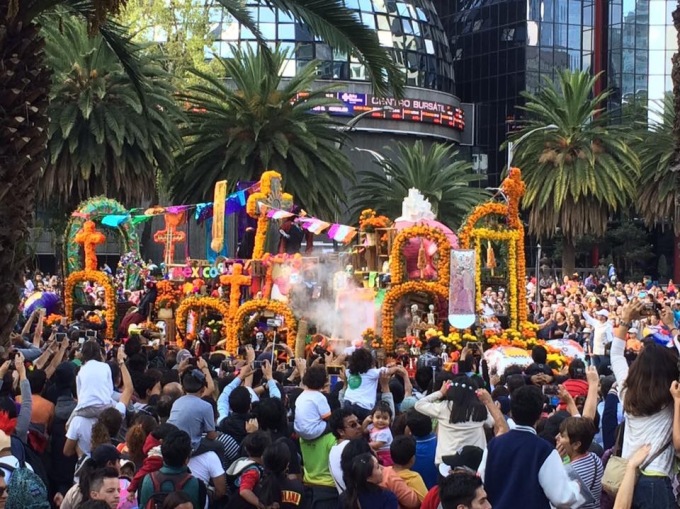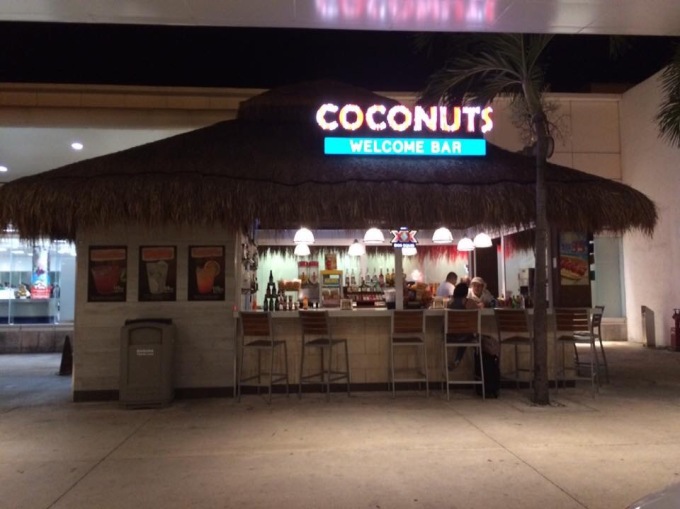If I’m perfectly honest, when I was planning my trip (which pretty much involved deciding on the cheapest one-way flight I could find), I had no intention of going to Mexico. My original idea, was to head straight back towards South-East Asia, where prices are cheap and I could dive for next to nothing. My travel compass swiftly changed when I made the last minute decision to book a flight to Toronto and spend 3 months split between Canada and the USA.
It was all thanks to my fabulous French friend, Charlie (the proudest French person I know), had planned to visit Mexico City in October of twenty-sixteen, so I decided to follow his lead and fly down from New York City. It would have been a wasted opportunity for us to be on the same side of the world and not see each other. He did, after all, attend my party in the UK before I left for my year of travels. And I am so grateful that he suggested I join him. What a beautifully interesting city.
My favourite building – Casa de los Azulejos (House of Tiles)
Like most countries in the world, the capital city is generally the place that you spend the night and leave on the first bus the following day. Expect for London. Everyone seems to love London. Anyway, Mexico City is the polar opposite. It is abuzz with crumbling architecture, cheap local roadside eateries (oh, those tacos) and accommodating, super friendly people. In fact, the nature of the Mexicans was one of the reasons I extended my intended stay. Everyone wants to get to know you, even if your Spanish is particularly terrible – guilty – they will try to have a broken conversation because they are genuinely interested in who you are and where you come from.
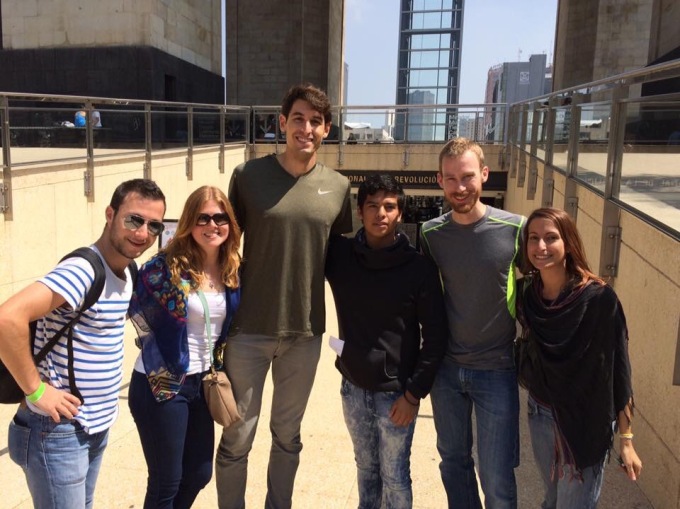 Helping a local with his English project for school
Helping a local with his English project for school
I was very lucky to be in that amazing city during Día de los Muertos (Day of the Dead). I did not experience the ambience of attending a cemetery during the festival, but I did go to the parade on the twenty-ninth of October. Apparently, it was the first year that they conducted the event, as it was inspired by the famous James Bond movie, Spectre.
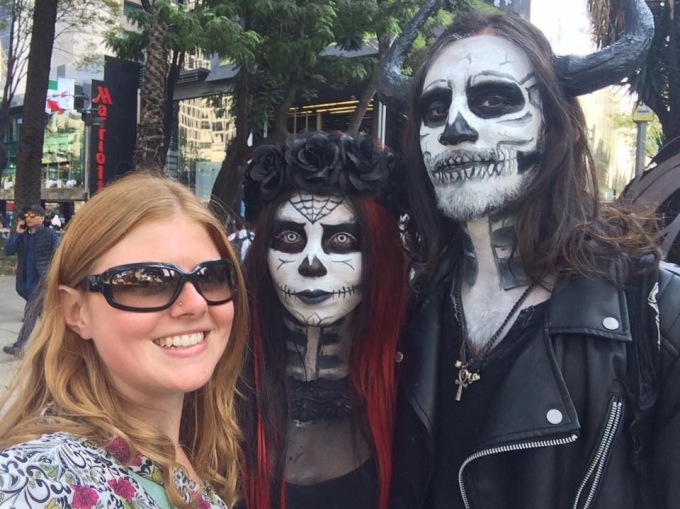 Amazing costume effort by the locals
Amazing costume effort by the locals
It felt like the entire population of Mexico City had come out to enjoy the new fiesta of native dancing, creepy costumes and the deep bass of Spanish music. Well done Bond, you’ve started something special.
Beyond the colourful wreaths of flowers, and competitions of oversized pan de muerto (bread of the dead, or ‘dead bread’ according to America) offerings, is an architect’s dream. You could explore the streets of Centro Historico for weeks and still come across a different church or even a ruined piece of lost Aztec heritage. Im going to give you a brief lesson to explain why the ruins of this city provide such a vibrant, if a little complicated, Mexican history.
Mexico City was once the ancient capital of Tenochtitlan. The Aztecs and the present citizens share the same appreciation for the centre of the city, known today as the Zócalo. It is one of the biggest main square’s in the world and has been used for ceremonial purposes, religious festivals and celebrations; true to form, it is where the Day of the Dead Parade finished and the musical fiesta began.
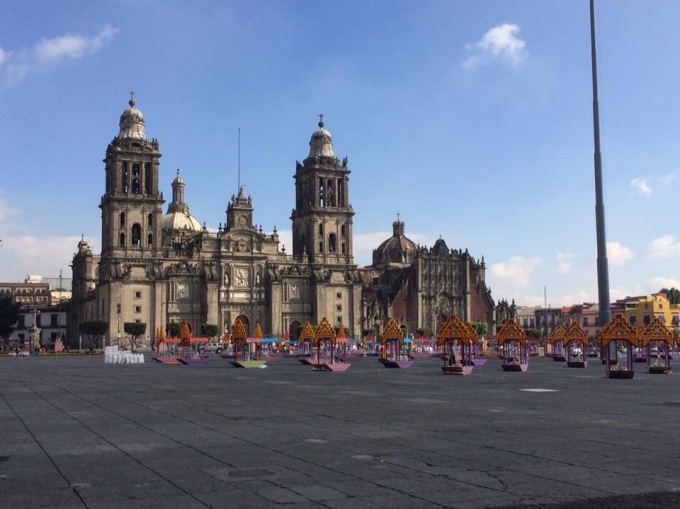 Zócalo – Day of the Dead Festival shrines in front of the Catedral Metropolitana de la Ciudad de Mexico (Metropolitan Cathedral of the City of Mexico)
Zócalo – Day of the Dead Festival shrines in front of the Catedral Metropolitana de la Ciudad de Mexico (Metropolitan Cathedral of the City of Mexico)
Adjacent to the Zócalo is the ruin of Templo Mayor. Originally, this was the location that the Aztecs considered to be the centre of the universe; all according to legend, of course, as is the popular phrase in many Central American museums. Unfortunately, I do not have a photo to post because I think it’s on my camera, not my phone, however, this website offers more in depth information and shares an image of what historians believe the site looked like when it was constructed.
A common theme that appears in the history of this archeological dream-world, is that many of Central America’s ancient cities were overthrown by greater forces. For example, the Aztecs conquered the Mayans and muscled them out of their homes. Many ancient treasures of this world have been lost due to years of pillaging, or piracy, or, in a strange not-quite-justified kind of way, recycling. This brings me back to our modern day plaza in Mexico City, the Zócalo. After the conquest over the Aztecs in fifteen-twenty-one, the Spanish disassembled the beloved centre of the universe, Templo Mayor, and used its bricks to pave the Zócalo plaza. This savage destruction is peppered throughout all of Central America’s history. Templo Mayor is now a museum and a sad looking archeological site tucked away behind the beautifully decaying Cathedral. If you were touring the city, and didn’t know of it’s presence, you would probably miss it.
Another stunning piece of architecture in the city is the picture perfect, front cover dominating, Palacio de Bellas Artes. This museum mainly houses art collections, but also has a permanent exhibition featuring models and photographs that depict the work of Mexican architects.
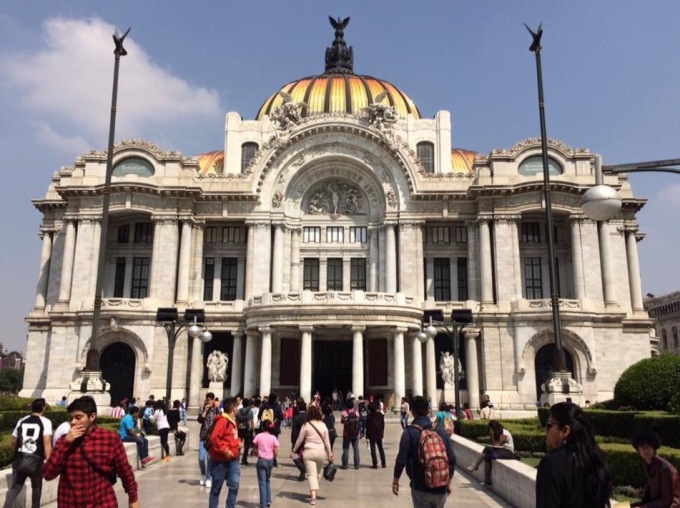 The front of Palacio de Bellas Artes
The front of Palacio de Bellas Artes
I did not visit the museum itself due to time constraints (as per usual), but I did go to the free tour of the fully functioning theatre inside. Now this was something special. This is where you can watch performances of the Ballet Folklorico de Mexico and of the National Symphonic Orchestra. Sitting on one of those soft red velvety chairs in the audience, I looked up at the heavy marble walls and intriguing safety curtain hiding the stage. That curtain alone weighs twenty-seven tonnes. Built by Tiffany and Company of New York, it is a mosaic made from a million tiny pieces of crystal to create a shimmering stained-glass-effect masterpiece of a Mexican valley. The image features two active volcanoes, Popocatepetl and Iztacchihuatl, both of which can be found bubbling away South of Mexico City, in the state of Puebla.
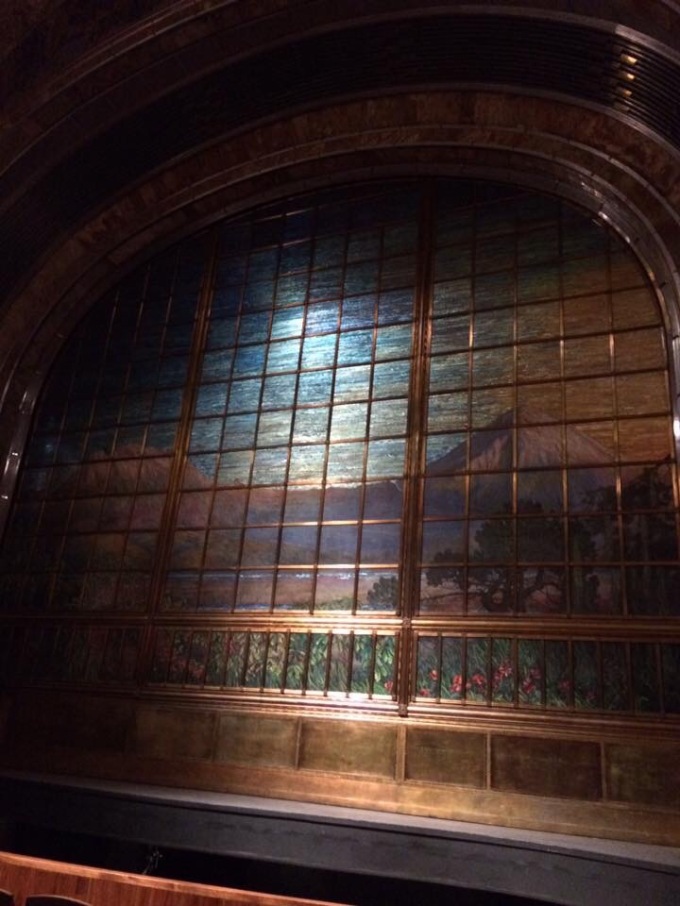
Tiffany’s marvellous crystal creation – the lighting inside wasn’t the best for amateur photographer skills
Fun fact – Mexico City was originally built on lake Texcoco. Because of this, the immense weight of the marble structure and the Tiffany curtain are a heavy burden for Bellas Artes, resulting in the loss of two to three centimetres of the building each year, as it sinks into the earth.
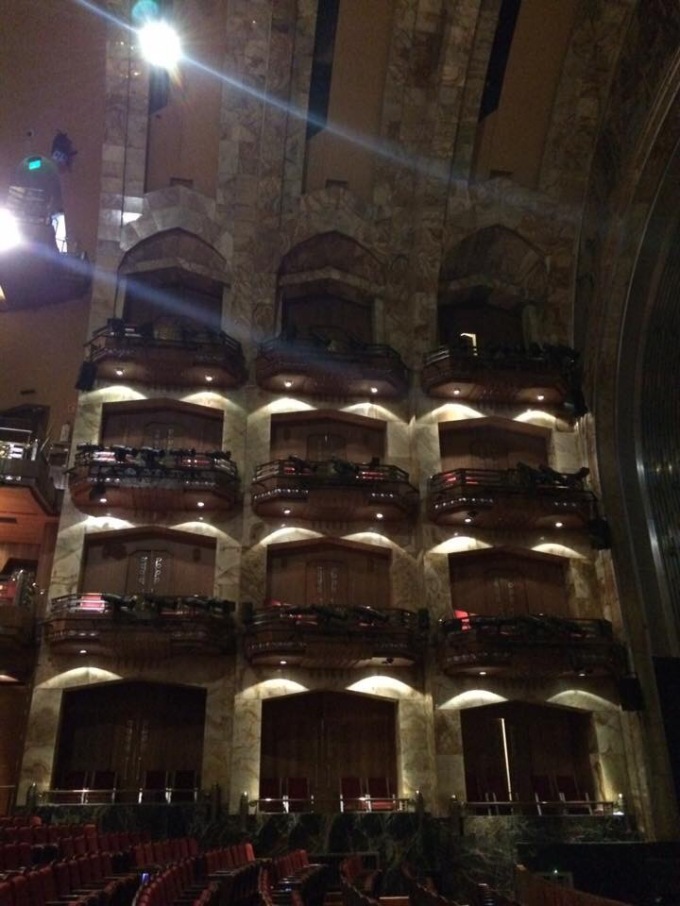
An example of the marble inside the theatre – my photos do not do it justice
So, I spent ten wonderfully jam-packed days of exploring Mexico City and its surrounding delights. And believe me, this was still not enough time. Fortunately, The airport tends to be a very cheap destination to fly into as it is an international connecting hub, so hopefully I’ll find my way back there one day. Actually I know I will. I completely intend to. It is a city with surprise around every corner, so don’t be afraid to explore side streets, local markets and buildings, just check with the security guard on the door that you’re allowed inside first!
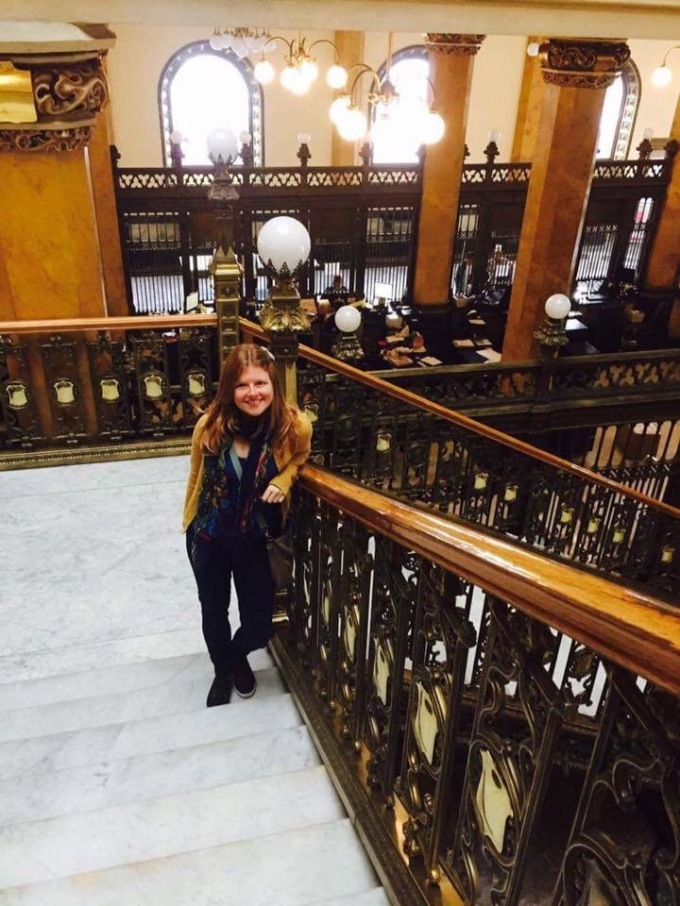
Inside the post office – I fell in love with the iron staircase and elevator
My original intention after this was to head straight to the famous Tikal ruins of Guatemala, but something kept me anchored to that smoky taco-pregnant country for a few days more. With a cheap ticket to Cancun purchased, I got on the easiest Metro in the whole world (they have pictures for each stop) and made my way to the airport.
Cancun Airport – Get yourself a cheeky cocktail before you get on the bus to Cancun
This post was written to the sounds of orchestral Nicaraguan street music and deafening bangs of fireworks at six-thirty in the morning.
